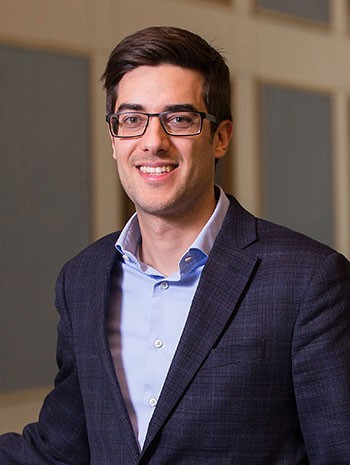Air Force Young Investigator Award funds study of waves, topology
By Syl Kacapyr
Francesco Monticone, assistant professor of electrical and computer engineering, will help push the scientific boundaries of topological systems – and help imagine new metamaterials with exotic properties, such as the ability to bend light and other electromagnetic waves – with a three-year, $450,000 Young Investigator Award from the Air Force Office of Scientific Research.
The field of topological physics and its engineering applications have seen a surge of interest in recent years as researchers look for ways to design new materials and combine them to gain properties that are preserved under deformation. But while most researchers have focused on “closed” topological wave-guiding systems, the interaction between “open” topological structures and electromagnetic waves remains largely unexplored.
Monticone’s new research project, “Robust Topological Scattering and Radiating Structures: Bridging Free-Space Propagation and Surface Waves on Complex Objects,” will examine the interaction of engineered surfaces and electromagnetic waves, and use that knowledge to demonstrate a new degree of control over how the waves are captured by a surface, propagated and radiated.
For example, an object is visible because light waves scatter off its surface and travel to an observer’s eyes. But if the object could prevent the light from scattering and instead guide the light away from the observer, it would essentially become invisible.
“And if the material structure possesses nontrivial topological properties, it wouldn’t matter what the exact shape of the object is. It can be a complex shape like the wing of an airplane that changes and moves as you operate it, and yet you would be able to reroute the electromagnetic energy around that shape without any reflection,” said Monticone, adding that this type of topological system is possible, but the exact limits and applications of robust topological scattering are unknown.
Materials manipulate electromagnetic waves, such as light and radio signals, based on how their atoms are naturally arranged. By combining multiple materials and arranging their atoms in strategic patterns that are much larger than the natural atomic distances of each material, but smaller than the waves with which they are interacting, metamaterials can alter the waves in ways natural materials can’t.
Monticone will develop a comprehensive theoretical analysis of topological radiating and scattering structures and help design and numerically verify new materials with special topological properties.
“We hope to design topological meta-skins – namely, thin metamaterial layers for wave rerouting and transmission around arbitrarily complex objects,” said Monticone. “Or robust topological antennas that would still work even if damaged. And if the materials we have available are not enough for what we want to do, we can design new metamaterials.”
Other applications of Monticone’s research may include novel electromagnetic and optical devices for efficient communications and information processing, classical and quantum, that would be inherently robust to imperfections and disorder. Examples include: defect-immune optical interconnects and delay lines; communication systems able to transmit and receive simultaneously; enhanced light-matter interactions; and scattering-free platforms for quantum information processing.
Monticone’s proposal was among 31 chosen this year from a field of 290 proposals.
Syl Kacapyr is public relations and content manager for the College of Engineering.
Media Contact
Get Cornell news delivered right to your inbox.
Subscribe

